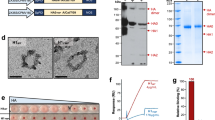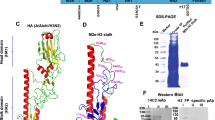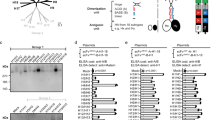Abstract
The ability of the C3d component of complement to enhance antibody responses and protective immunity to influenza virus challenges was evaluated using a DNA vaccine encoding a C3d fusion of the hemagglutinin (HA) from influenza virus. Plasmids were generated that encoded a transmembrane HA (tmHA), a secreted form of HA (sHA), or a sHA fused to three tandem copies of the murine homologue of the C3d (sHA-3C3d). Analysis of the titers, avidity maturation, and hemagglutinin-inhibition activity of raised antibody revealed that immunizations with sHA-3C3d DNA accelerated both the avidity maturation of antibody to HA and the appearance of hemagglutinin-inhibition activity. These accelerated antibody responses correlated to a more rapid appearance of protective immunity. They also correlated to complete protection from live virus challenge by a single vaccination at a dose ten times lower than the protective dose for non-C3d forms of HA.
This is a preview of subscription content, access via your institution
Access options
Subscribe to this journal
Receive 12 print issues and online access
$209.00 per year
only $17.42 per issue
Buy this article
- Purchase on Springer Link
- Instant access to full article PDF
Prices may be subject to local taxes which are calculated during checkout






Similar content being viewed by others
References
Subbarao, K. Influenza vaccines: present and future. Adv. Virus Res. 54, 349–373 (1999).
Andrew, M.E., Coupar, B.E.H., Boyle, D.B. & Ada, G.L. The roles of influenza virus haemagglutinin and nucleoprotein in protection: analysis using vaccinia virus recombinants. Scand. J. Immunol. 25, 21–25 ( 1987).
Robinson H.L. et al. DNA immunization for influenza virus: studies using hemagglutinin- and nucleoprotein-expressing DNAs. J. Infect. Dis. 176, S50–55 (1997).
Portela, A., Zucker, T., Nieto, A. & Ortin, J. Replication of Orthomyxoviruses . Adv. Virus Res. 54, 319– 348 (1999).
Murphy, B.R. & Webster, R.G. in Virology 2nd edition (eds Fields, B.N. et al.) 1091–1152 (Raven Press, New York, (1990).
Seder, R.A. & Gurunathan, S. DNA vaccines-designer vaccines for the 21st century. N. Engl. J. Med. 341, 277–278 (1999).
Donnelly J.J., Ulmer, J.B. & Liu, M.A. DNA vaccines. Dev. Biol. Stand. 95, 43–53 (1998).
Robinson H.L. & Pertmer, T.M. DNA vaccines for viral infections: Basic studies and applications. Adv. Virus Res. ( 2000) (in the press).
Robinson, H.L., Hunt, L.A. & Webster, R.G. Protection against a lethal influenza virus challenge by immunization with a hemagglutinin-expressing plasmid DNA. Vaccine 11, 957–960 ( 1993).
Zuckerman, M.A. et al. Serological response in volunteers to inactivated trivalent subunit influenza vaccine: antibody reactivity with epidemic influenza A and B strains and evidence of a rapid immune response. J. Med. Virol. 33, 133–137 ( 1991).
Rimmelwaan, G.F. et al. Induction of protective immunity against influenza virus in a macaque model: comparison of conventional and iscom vaccines. J. Gen. Viral. 78, 757–765 (1997).
Dempsey, P.W., Allison, M.E.D., Akkaraju, S., Goodnow, C.C. & Fearon, D.T. C3d of complement as a molecular adjuvant: Bridging innate and acquired immunity. Science 271, 348–350 (1996).
Fearon, D.T. & Carter, R.H. The CD19/CR2/TAPA-1 complex of B lymphocytes: linking natural to acquired immunity. Annu. Rev. Immunol. 13, 127–149 ( 1995).
Gething, M.J. & Sambrook, J. Construction of influenza hemagglutinin gene that code for intracellular and secreted forms of the protein. Nature 300, 598–603 ( 1982).
Pullen, G.R., Fitzgerald, M.G. and Hosking, C.S. Antibody avidity determination by ELISA using thiocyanate elution. J. Immunol. Meth. 86, 83– 87 (1986).
Fearon, D.T. The complement system and adaptive immunity. Semin Immunol. 10, 355–361 (1998).
Berek, C., Berger, A. & Apel, M. Maturation of the immune response in germinal centers . Cell 67, 1121–1129 (1991).
Jacob, J., Kelsoe, G., Rajewsky, K. & Weiss, U. Intraclonal generation of antibody mutants in germinal centres. Nature 354 , 389–392 (1991).
Ahearn, J.M., et al. Disruption of the CR2 locus results in a reduction in B-1a cells and in a impaired B cell response to T-dependent antigen. Immunity 4, 251–262 ( 1996).
Potter, C.W., Jennings, R., Phair, J.P., Clarke, A. & Stuart-Harris, C.H. Dose response relationship after immunization of volunteers with a new surface-antigen-adsorbed influenza virus vaccine. J. Infect. Dis. 155, 423– 431 (1977).
Scholtissek, S. & Grosse, F. A cloning cartridge of λ to terminator. Nuc. Acids Res. 15, 3185 (1987).
Torres, C.A. T., Yang, K., Mustafa, F. & Robinson, H.L. DNA immunization: effect of secretion of DNA expressed hemagglutinins on antibody responses in preparation. Vaccine 18, 805– 814 (1999).
Pertmer T.M. & Robinson, H.L. Studies on antibody responses following neonatal immunization with influenza hemagglutinin DNA or protein . Virology 257, 406–414 (1999).
Haynes, J.R., Fuller, D.H., Eisenbraun, M.D., Ford M.J. & Pertmer, T.M. Accell particle-mediated DNA immunization elicits humoral, cytotoxic, and protective immune responses. AIDS Res. Hum. Retroviruses. 10, S43–45 (1994).
Pertmer, T.M. et al. Gene gun based nucleic acid immunization. eliciting of humoral and cytotoxic T lymphocyte response following epidermal delivery of nanogram quantitation of DNA. Vaccine 13, 1427– 1430 (1995).
Montgomery, D. L. et al. Heterologous and homologous protection against influenza A by DNA vaccination: Optimization of DNA vectors. DNA Cell Biol. 12, 777–783 ( 1993).
Acknowledgements
We thank D. Campbell and S. Winburn for technical assistance with serum collection, T. Tumpey from the Centers for Disease Control and Prevention for providing influenza A/PR/8/34–infected chicken lung homogenate and J. Katz for discussions. Supported by National Institute of Allergy and Infectious Diseases grant awards R21 AI44325 (T.M.R.) and R01 AI34946 (H.L.R.).
Author information
Authors and Affiliations
Corresponding author
Rights and permissions
About this article
Cite this article
Ross, T., Xu, Y., Bright, R. et al. C3d enhancement of antibodies to hemagglutinin accelerates protection against influenza virus challenge. Nat Immunol 1, 127–131 (2000). https://doi.org/10.1038/77802
Received:
Accepted:
Issue Date:
DOI: https://doi.org/10.1038/77802
This article is cited by
-
Next generation methodology for updating HA vaccines against emerging human seasonal influenza A(H3N2) viruses
Scientific Reports (2021)
-
Expression vector cassette engineering for recombinant therapeutic production in mammalian cell systems
Applied Microbiology and Biotechnology (2020)
-
Ensilication Improves the Thermal Stability of the Tuberculosis Antigen Ag85b and an Sbi-Ag85b Vaccine Conjugate
Scientific Reports (2019)
-
Molecular-level analysis of the serum antibody repertoire in young adults before and after seasonal influenza vaccination
Nature Medicine (2016)
-
Linking complement and anti-dsDNA antibodies in the pathogenesis of systemic lupus erythematosus
Immunologic Research (2013)



